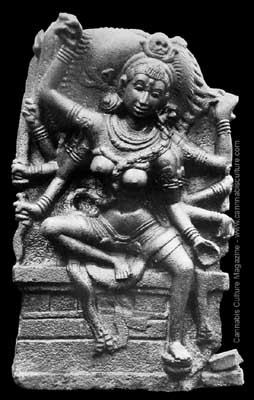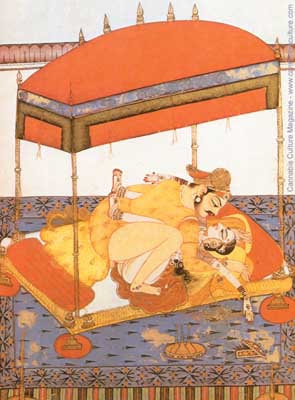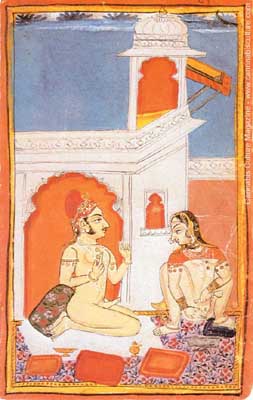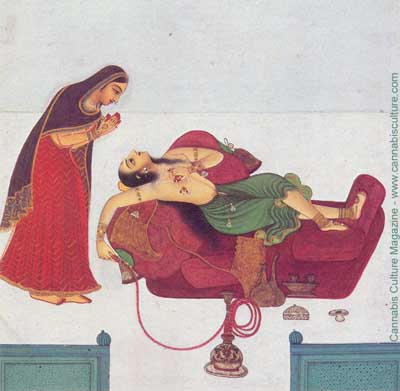
Ancient pot-sex Goddess Kali, From a 12th Century Indian temple.Tantra
Marijuana and Sex: A Classic Combination
By Terry Necco on September 1, 1998
http://www.cannabisculture.com
Marijuana and sex are gifts of nature. We enjoy them because biology
and evolution have equipped us to do so. Just as our bodies contain pleasure
systems which reward us for sex; our brains contain neurocellular circuitry
which can only be activated by substances with THC’s molecular structure. This
makes the marijuana high a unique constellation of feelings, and there are only
two sources for the substances which activate THC’s very own neuroreceptor. Our
brain is one source: it generates a neurochemical very similar to THC, called
anandamide.
Translated, the word means bliss. The only other source for this bliss-producing
substance is the cannabis plant.
Being stoned or sexually aroused both produce similar physiological responses, such as increased heart rate, heightened sensitivity, changes in blood flow and respiration, relaxation ? an acutely altered state of consciousness. Neurochemistry, hormonal systems, and brain regions such as the temporal lobe are affected by both marijuana and sexual arousal.
Sex and pot provide us with euphoric peak experiences, unity of body and mind, a healing escape from routine existence. If other people are involved with us in sexual activity or marijuana use, such experiences can be especially intimate and revelatory, facilitating trusting, loving relationships.
Pot the aphrodesiac
Marijuana has been used as an aphrodisiac for thousands of years, yet ironically it has also been used to decrease sexual desire. Ancient sacred texts reveal how to use marijuana to increase sexual pleasure, but modern research teaches an equally important lesson: marijuana’s effects are determined by the personality, physiology, intention, environment, and culture of the user.
Ancient India
The culture of ancient India is closely associated with sexual marijuana use. Cannabis has been used in India for at least 3,000 years, probably much longer. The Indian Ayurvedic and Unani Tibbi medicine systems used cannabis to increase libido, conquer impotence, and cure various diseases. These systems also utilized opium, sometimes in combination with cannabis.
Dozens of formulations containing cannabis were prescribed as aphrodisiacs. Their names are delicious: shrimadananda modaka, uttama vajikarana, majun falaskari, roghan bhang, among others. These formulations were reputed to produce long-lasting erections, delay ejaculation, facilitate lubrication and loosen inhibitions.

Ancient pot-sex Goddess Kali, From a 12th Century Indian temple.Tantra
Sexual cannabis use which transcended hedonism and medicine rose up in an esoteric Hindu-Buddhist tradition known as Tantra, a mystical religion which prescribes physical and mental exercises like meditation and yoga. These practices are intended to help the practicioner escape suffering and achieve enlightenment and perfection, known as Nirvana.
Advanced Tantra marijuana rituals were intense, complex and difficult. Researchers have uncovered sacred texts describing cannabis rituals, but doubt that modern Tantra practitioners still engage in such activities.
Modern Tantra has, like many other indigenous spiritual practices, been co-opted by people with little connection to the cultures, communities and environments from which the religions arose. Modern Tantra, though an important source of sexual and spiritual enlightenment, scarcely resembles the hard-core Tantra described in sacred writings like the Mahanirvana Tantra, which was composed in the 11th century AD.
Tantra practitioners believe that human bodies contain energy systems consisting of nerves, heart and spiritual elements that are linked to cosmic and nature-based energies. Males and females have differing degrees and types of energy; and yogic sexual practices unite these energies, creating “circuits” which allow participants to find new heights of intimacy and to transcend egocentric consciousness, helping them realize their timeless place in the universe. Tantric union of male and female energies is thought to facilitate universal balance and to atone for human sins against nature and the cosmos.
Tantra cannabis rituals date back at least to 700 AD, and involved groups of “purified” male and female worshippers who engaged in fasting, chanting, prayer, ceremonial purifications, Kundalini yoga, and sexual union, subjecting body and spirit to excruciating and ecstatic ordeals. Concentration, consecration and transformation were the goals of such rituals, which were conducted in temples festooned with thousands of flowers, clouds of incense smoke, and flickering temple lamps.

Ivory painting, Ganges Valley, circa 1840-80.Bhang
Tantra practitioners didn’t smoke pot ? they made an orally ingested cannabis preparation called bhang. Sometimes the bhang was nothing more than a green ball of cannabis mixed with milk, but it could also be a delicious marijuana milkshake made from prime resin-laden cannabis flowers and leaves, mixed with milk, sugar, pepper, almonds, cardamom, poppy seeds, ginger and other herbs. These preparations were heated before serving to allow fat-soluble THC the opportunity to catalyze into a pyschoactive form effective on humans.
Bhang made from such recipes is similar to chai, but sweeter and thicker, seasoned by the unmistakable taste of cannabis. Even in modern India, bhang is considered a sacred medicinal drink which cures illness, brings good luck, wards off evil spirits and cleanses people of sins.
After fasting and purging for at least 24 hours, Tantric celebrants ingested
bhang, accompanied by deep abdominal breathing and visual imaging exercises.
These exercises free blocked energy, tonify muscles and blood flow, and
facilitate the power and onset of cannabis intoxication, which usually occurs
within an hour of swallowing the spicy, potent libation.
Practitioners often experienced initial queasiness from the bhang, which is
medicinally active as a digestive tract purgative. As the brew’s psychoactive
effects become pronounced, practitioners enter a meditative state in which they
reaffirm earlier vows which sanctify and praise Kali, the Tantric-Hindu goddess
embodying feminine creative forces.
Ritual worship of beauty
Enshrinement of feminine beauty and energy continues: males ritually bathe and sanctify their female partners, washing them with holy water, scenting and combing their hair, perfuming them, and arranging them on a silken bed. Males then perform a programmed ritual in which they touch the woman’s forehead, eyes, nostrils, mouth, arms and thighs, finally touching the vagina itself.
The two overtly sexual acts which take place during cannabis rituals are intercourse and the performance of oral sex on the female by the male. During sex, the partners focus on religious symbolism, the mingling of energies and the liberating nature of sexuality.
Tantric ritual seeks to prolong sexual union as long as possible. Males and females use yogic breathing, meditation and neuromuscular control to achieve “endless orgasms” without ejaculation or other tiring release. Sacred texts describe cannabis-assisted intercourse lasting for seven or eight hours, until a glow of fire envelops the lovers in total-body orgasms, which result in erasure of mental ideations and ego ? the timeless freedom from self which equals Nirvana.

Rajastan, Bundi State, circa 1800-20.Other cultures’ pot-sex
The Indian uses of Tantra and marijuana are probably the most beautiful and moving interactions between sexuality and cannabis, but other cultures also have sexual cannabis lore.
Folk medicines in 19th century Serbia relied on cannabis preparations, which they called nasha. Female virgins were given mixtures of lamb’s fat and cannabis on their wedding nights, to decrease the pain of their first intercourse. Such use echoes modern practices in India, where newlyweds drink bhang beverages and eat bhang candy. Indian prostitutes are reported to eat lots of bhang sherbet, which helps them feel sexually aroused even when their customers are fat, ugly and stupid.
Serbian women mixed cannabis with egg whites, saffron and sugar to make guc-kand, a tonic which created a sexy mood or (ironically) was given to young boys to lessen the pain of circumcision! Cannabis tonics were also given to crying and pouty children, and it was reported to perk them right up into the smile zone.
Serbian men valued a mixture made from potent hashish, almond butter, dried rose leaves, carnation petals, crocus, muscut nut, cardamom, honey, sugar, and Anacylius pyrethrum root. They considered this “happy porridge” a super aphrodisiac.
Morocco, Egypt, Lebanon and other Middle Eastern and Northern African cultures utilized cannabis for sexual purposes as recently as the early 20th century. There, cannabis was usually encountered in a particularly potent form called kif. Wives and concubinese procured kif from servants and used it when men were not around, often engaging in erotic fantasies and play. Cannabis had the reputation of allowing women to become sexually uninhibited, which was an especially important benefit in cultures where they were routinely oppressed.
Contemporary Cannabis Sexuality
In countries such as Canada and the United States, interactions between cannabis and sexuality is complicated by gender politics, Puritanism, laws and the stresses of industrial living.
A few research articles and books provide useful information about cannabis and sex. These researchers concluded that people who enjoy marijuana tend to enjoy sex, and (surprise!) that marijuana and sex can be a powerful combination.
A majority of users reported that they got hornier when they were stoned, but explained that increased lust occurred in situations where a person would normally have felt sexy. Users said that not only was desire increased, their ability to appreciate sexual pleasure was enhanced when they were high.

A painting from the Bundi State, circa 1800-20.Less is more
Intoxication levels influence marijuana’s effects on sex. At low to moderate levels of intoxication, users reported heightened ability to communicate sexually with their partners, and increased body awareness. Some users reported that being “very stoned” tended to make them introspective and withdrawn; the marijuana high overwhelmed the user and displaced sexual activity. Others said that when they were extremely high they lost kinesthetic connection with their bodies and were unable to perform sexually because their consciousness was high above the physical realm.
When marijuana dosage was appropriate, however, users reported that it increased sexual stamina and skill, tactile sensation, length and power of orgasms, and emotional bonding between partners. People felt they became more loving, more willing to pay attention to the technical aspects of lovemaking and foreplay which women complain is often missing from male sexual repertoire.
Many men reported that their erections were bigger and harder when they were high; women felt that they became wetter, and more able and willing to contract vaginal muscles to maximize sensation for the male. Stoners of both sexes said that being high sometimes allowed them to acknowledge erotic feelings for people whom they had formerly considered as “just friends.”
Some women said that they were sexually blocked when unstoned but easily became sexually aroused while high. Some women reported that only when high were they able to achieve orgasm, other women said being stoned helped them achieve multiple orgasms. For both sexes, orgasms were likely to be felt in the entire body, rather than confined to the genital area. Stoned sexers became more aware of cues leading to orgasm and felt freer to engage in body movements which increased pleasure.
Modern users reported spiritual, emotional and psychological effects that mirrored ancient Tantric effects. While high, they felt that intercourse was an exchange of energies which united their bodies in a cosmic circuit. They felt that this exchange was replenishing and balancing, and that orgasm was an energizing climax to sex, instead of a draining finale.
Some respondents said that sex while high lifted them past ego into spiritual
realms, where the sex act took on symbolic and universal importance. Many also
noted that marijuana seemed to help them feel more love for their partners, and
more gratitude for sexual function as a means of communicating “far more
powerful than words or other actions could ever be.”
Marijuana users experienced in yoga and meditation felt that marijuana increased
their awareness of inner organs and subtle internal processes.
Love Mechanisms
Although nobody has identified the mechanisms which account for marijuana’s apparent usefulness as an aphrodisiac, the drug’s reputation as a sensory enhancer and emotional revealer probably account for much of the effect. Marijuana users report that being high usually increases temperature perception, taste, touch, visual stimulation, body awareness, musical-auditory enjoyment, fantasy production, and mood. Other common effects include changes in time perception which often lead to a feeling that time has slowed down so more information is being processed and felt.
Ironically, these same effects have been cited by people who feel that marijuana interferes with enjoyment of sex. Indeed, ascetics, monks and others have used marijuana to free themselves of sexual desire. For them, the drug produces introspection and detachment. Instead of connecting them to their bodies, sexual desires, or other people, it helps them dwell meditatively on abstract mental concepts, on religious goals, or even on nothing at all.
Some couples reported that being high made them more aware of flaws in their relationships, which did little to put them in the mood for lovemaking! Others said being stoned increased non-sexual ideas which distracted them from their bodies and their partners, and made sex more difficult. One couple said that while making love stoned their minds wandered ? they found it more interesting to discuss the meaning of life than to continue lovemaking.

Longing: 18th Century painting, Rajput era.Solo & Homo
You’ve probably noticed that the marijuana-sex research reported here focusses on heterosexuality and fails to mention masturbation or homosexuality. Specific research into cannabis and homosexual sex is virtually non-existent. The few studies that mention marijuana and masturbation indicate that being high tends to increase masturbatory pleasure because it enhances tactile inputs and fantasy creation. People who like to use cannabis alone also tend to like to have sex alone, with themselves!
Some studies reveal stereotypical gender differences: women tend to be more conservative than men in their use of marijuana to enhance sexual pleasure and in ability to give up control and enjoy a drug-induced state of intensely heightened sexual arousal. One woman complained to researchers that being high had caused her to “have sex with a man I didn’t love.” Another said she was afraid of cannabis because it made her “have sex just for the sake of the pleasure instead of in a monogamous relationship.”
The “typical” male attitude toward sex can be seen in the statements from a man who said “There’s that joke about women needing a reason to have sex but men just need an opportunity. I have sex because I love the sensation, I love the woman’s body, I love to see her orgasm.
It’s the same reason I get high ? I’m a hungry hedonist. But I think women have sex for a whole bunch of other reasons. It’s very hard for them to have sex just because it feels good, and I think that being high can upset them because they get looser than they want to be. They realize that a skilled lover, even somebody they’ve just met, can get them off if they let themselves be open to it. They’ve been told that they have to be in love in a committed relationship for sex to be honorable and great, but cannabis turns them on to the fact that no they don’t, they just have to be open to good feelings.”
Contrary to the reefer madness myth that marijuana automatically causes uncontrollable sexual desire, we see that although cannabis and sexuality have been closely related for thousands of years, each of us has a unique set of psychosexual parameters which determine whether marijuana will magnify or decrease sexual desire and enjoyment.
A smoking relationship
An anthropologist notes that cannabis religions recognize the metaphysical potential of the female cannabis plant.
“Cultures with sacred cannabis use tend to be cultures which recognize the ‘goddess’. That could mean mother earth, yin, or female beauty and virtues. People who bring marijuana inside themselves are engaging in a type of sexual union with the plant. It is a very sexual act to have a molecule of THC implant itself into your brain.
“Since cannabis is associated with female dieties like
Kali, we could say that when you use marijuana sexually, you are bringing a very
special ‘woman’ into your bed. Make sure you’re ready for that relationship.”![]() Longing: 18th Century painting, Rajput
era.
Longing: 18th Century painting, Rajput
era.